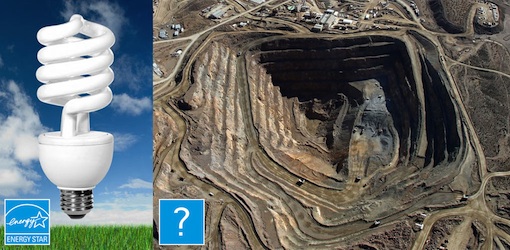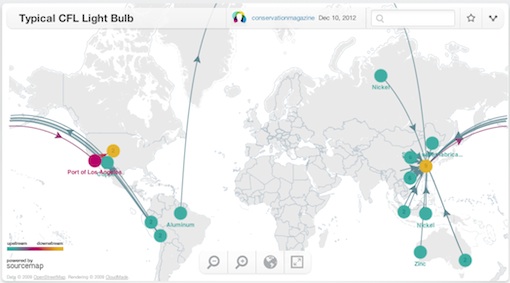Calculating Value
Posted on December 13, 2012 | posted by:It seems like almost every product I buy these days has a green leaf, an Energy Star, or a recycle triangle stamped on it. If I can’t find one, I consider whether or not the purchase of that particular brand or product reflects a responsible decision. I have been trained not to base my decisions on independent research and knowledge but on the claims that manufacturers print on their packaging. These hyped up icons of the “new green asceticism” (so named by the Invisible Committee) distract our sensibility and confuse the ultimate issues. Acutely aware of the pressing issues, our sense of responsibility urges us to commit to the recognizable signs of the cause but we seldom have the whole picture when we browse products on a shelf. Don’t get me wrong; I totally support the green movement and think that for the consumer it represents sincere concerns about climate change. However, the faith we commit to “green” icons and package labels needs serious reevaluation. Instead of blindly accepting vague, post-production energy efficiency ratings like Energy Star, we should develop systems of value that are regionally sensitive and account for the entire life cycle of a product.
It is difficult for a culture accustomed to shopping in retail chains like Walmart and Home Depot to consider the significance of regional diversity. Our relentless drive towards globalization has spread systems of commerce from city to international city and it is through these embedded channels of mass production that the market delivers its generic monoculture. Following our proven trade models of profit, the more generic a product, the cheaper it is to produce and distribute. If it’s cheap, then it’s everywhere and must appeal to everyone. We are subsequently inundated in “green washing” and blanket environmental policy reform that responds little to the unique needs or demands of our individual regions or communities. Keller Easterling speaks to the uniformity of massive trans-commerce when he examines the behavior of these systems in Enduring Innocence. In these circumstances, “flexibility” is not an idea that addresses individual characteristics of the market. Instead, it is the ability to process user information in order to reframe consumer demand so that it aligns more with the system of delivery. Easterling states, “They require information of others not so that they can alter themselves, but so that others can alter themselves to conform to their protocols.” Certainly, the perceptions of value held for this style of commercial trade greatly outweigh those that relate to regional identity and the varying circumstances of environmental predicaments within of our unique communities.
Take, for instance, the emission-free electric car. The debate over its environmental implications continues to rage and assessments of its value are widely varied. Vast private and government resources are deeply invested in the electric car industry’s potential to revive our struggling automobile industry and maintain our image as the same technologically savvy nation that birthed the Model T. But these value judgments can be debated on several levels. First of all, the term “zero emissions” is problematic. Depending on where the car is used, the electricity needed to charge the batteries in the car could be generated by anything from coal to wind and even this varies by time of day. Running a car off electricity when you are serviced by coal has a very different impact than service by wind or solar. In situations that involve energy consumption, regional differences are key.
To make the situation even more complicated, consider the environmental impact produced by the manufacturing, maintenance, and post-consumer life of the car (see abstract at bottom of post). So, who is responsible for calculating the environmental impacts of production and incorporating them into those value ratings so prominently displayed on labels and packages? How is a conscientious consumer meant to calculate a value offset that accounts for the intense strip mining and energy consumption required to obtain rare earth elements for the batteries, solar panels, and wind turbines that constitute so much of our green technology? Many of these choices involve serious ethical considerations but, ultimately, much more information is needed by us, the consumers, if we are to make informed decisions based truly on environmental factors, not trendy, eco-friendly consumer fads. 
The crux of the problem really comes down to how we interpret the value of whatever natural capital is consumed in production. We read in Natural Capitalism that “It has been estimated that only 6 percent of [the US economy’s] vast flows of materials actually end up in products. Overall, the ratio of waste to the durable products that constitute material wealth may be closer to one hundred to one.” Yikes. The authors go on to say, “This waste is currently rewarded by deliberate distortions in the marketplace, in the form of policies like subsidies to industries that extract raw materials from the earth and damage the biosphere.” This lends a certain amount of confusion to the massive subsidization programs for products like compact fluorescents. CFLs represent another highly contentious product whose value is highly debatable. Developed as an energy saving alternative for the traditional carbon filament light bulb, it has been highly subsidized by the government, buoyed by laws outlawing incandescent lamps, and is extensively supported by a massive advertising campaign that rides on the back of environmentalism. However, the numbers in the field do not support the overly simplistic equations on the box. Light output discrepancies are attributed to heat, usage intermittency, and poor quality regulations. The behaviors that promote sustained brightness and long life are not written on the box and neither are the health hazards that accompany breakage or improper disposal. Even the programs created to increase the awareness and implementation of CFL replacements are not accompanied by the necessary information to educate users about safe disposal and recycling.
Aside from the small blue Energy Star logo, there is no research or government issued metric available to the consumer at the point of purchase that can properly inform a decision based on the environmental impact of a product’s entire life cycle. Instead of arming every household with a light bulb that contains enough mercury to contaminate 6000 gallons of water or that causes a toxic air plume when it breaks, maybe we should consider policies that enforce clean, efficient energy at the point of origin, not put the responsibility on the backs of the consumer. CFLs and so-called zero-emission cars are great solutions for some circumstances but they must be accompanied by a system of user education so that ignorance does not exacerbate the problems already at hand. Only then will we have the tools to properly calculate value.
Abstract: Comparative Environmental Life Cycle Assessment of Conventional and Electric Vehicles
Electric vehicles (EVs) coupled with low-carbon electricity sources offer the potential for reducing greenhouse gas emissions and exposure to tailpipe emissions from personal transportation. In considering these benefits, it is important to address concerns of problem-shifting. In addition, while many studies have focused on the use phase in comparing transportation options, vehicle production is also significant when comparing conventional and EVs. We develop and provide a transparent life cycle inventory of conventional and electric vehicles and apply our inventory to assess conventional and EVs over a range of impact categories. We find that EVs powered by the present European electricity mix offer a 10% to 24% decrease in global warming potential (GWP) relative to conventional diesel or gasoline vehicles assuming lifetimes of 150,000 km. However, EVs exhibit the potential for significant increases in human toxicity, freshwater eco-toxicity, freshwater eutrophication, and metal depletion impacts, largely emanating from the vehicle supply chain. Results are sensitive to assumptions regarding electricity source, use phase energy consumption, vehicle lifetime, and battery replacement schedules. Because production impacts are more significant for EVs than conventional vehicles, assuming a vehicle lifetime of 200,000 km exaggerates the GWP benefits of EVs to 27% to 29% relative to gasoline vehicles or 17% to 20% relative to diesel. An assumption of 100,000 km decreases the benefit of EVs to 9% to 14% with respect to gasoline vehicles and results in impacts indistinguishable from those of a diesel vehicle. Improving the environmental profile of EVs requires engagement around reducing vehicle production supply chain impacts and promoting clean electricity sources in decision making regarding electricity infrastructure.
http://onlinelibrary.wiley.com/doi/10.1111/j.1530-9290.2012.00532.x/abstract


